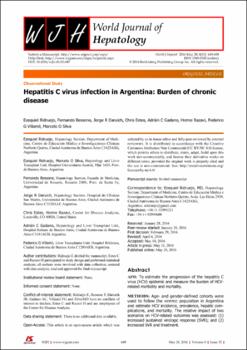| dc.description.abstract | AIM:
To estimate the progression of the hepatitis C virus (HCV) epidemic and measure the burden of HCV-related morbidity and mortality.
METHODS:
Age- and gender-defined cohorts were used to follow the viremic population in Argentina and estimate HCV incidence, prevalence, hepatic complications, and mortality. The relative impact of two scenarios on HCV-related outcomes was assessed: (1) increased sustained virologic response (SVR); and (2) increased SVR and treatment.
RESULTS:
Under scenario 1, SVR raised to 85%-95% in 2016. Compared to the base case scenario, there was a 0.3% reduction in prevalent cases and liver-related deaths by 2030. Given low treatment rates, cases of hepatocellular carcinoma and decompensated cirrhosis decreased < 1%, in contrast to the base case in 2030. Under scenario 2, the same increases in SVR were modeled, with gradual increases in the annual diagnosed and treated populations. This scenario decreased prevalent infections 45%, liver-related deaths 55%, liver cancer cases 60%, and decompensated cirrhosis 55%, as compared to the base case by 2030.
CONCLUSION:
In Argentina, cases of end stage liver disease and liver-related deaths due to HCV are still growing, while its prevalence is decreasing. Increasing in SVR rates is not enough, and increasing in the number of patients diagnosed and candidates for treatment is needed to reduce the HCV disease burden. Based on this scenario, strategies to increase diagnosis and treatment uptake must be developed to reduce HCV burden in Argentina. | en_US |


